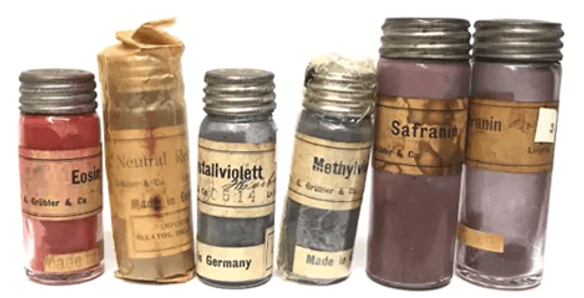Quality control and consistent reproducibility of results in staining is essential for accurate diagnosis. You’re probably familiar with the ways that you, within your own laboratory, can implement a quality control plan. You may even participate in a program like HistoQIP, which provides a quality control check on submitted slides, but what about before you even receive the materials used in your stains? How can you be sure that the powders and dyes manufactured by your vendors are what they say they are, every time you order them? That is where the Biological Stain Commission comes in.
To understand the origin of the Biological Stain Commission, or BSC, you first have to understand the inconsistencies in dyes being used in the 1800’s. As a wave of aniline dyes, like Eosin Y are developed in the period between 1850-1880, there’s no system for uniformity, and often no consistent name for a particular dye.
In 1880, a German pharmacist named Georg Grubler starts a business buying small batches of dye powders and testing them for common histological use. The ones that he finds to work well, he buys large batches of and sells them. This creates a rudimentary quality control system. People appreciate that the hard work of testing the dyes has already been done for them. Grubler’s stains become popular and soon even people in America are using his dyes. Fast forward to 1914; World War I breaks out and trade with Germany stops. America soon realizes that without Grubler’s stains, they are once again experiencing consistency problems. Dye powders are mislabeled, their hematoxylin is darker and creating poor staining, their methylene blue varied by supplier; they need a new way to guarantee the quality of the products they’re receiving.

By 1921, members of the National Research Council team up with the Will Corporation, the Chemical Foundation and Harold J. Conn, from the Society of American Bacteriologists to form a Committee for the Standardization of Biological Stains. This committee becomes the Biological Stain Commission, which is officially chartered in New York State in 1944.
The BSC today serves much the same purpose as Grubler’s 1880’s operation. Their laboratory, affiliated with the University of Rochester Medical Center in Rochester, NY ensures reliability of stains by providing certification to dye powders manufactured by histology vendors.
Vendors submit their dye powders to the BSC laboratory for testing. If the dye meets the BSC standards, they issue a certificate approving the dye for specific uses. You as the end user will probably never see a vendor’s actual certificate from the BSC but you will see a BSC label which indicates certification.

Interested in learning more about BSC services, the history of dyes, and how you can make sure your dye powders meet quality standards? Check out "Biological Stain Commission Certification Endorsement of Histological Stains", one of the on-demand sessions on elearn.nsh.org! Click here to register!
#2020#Blog#GeneralAnatomicPathology